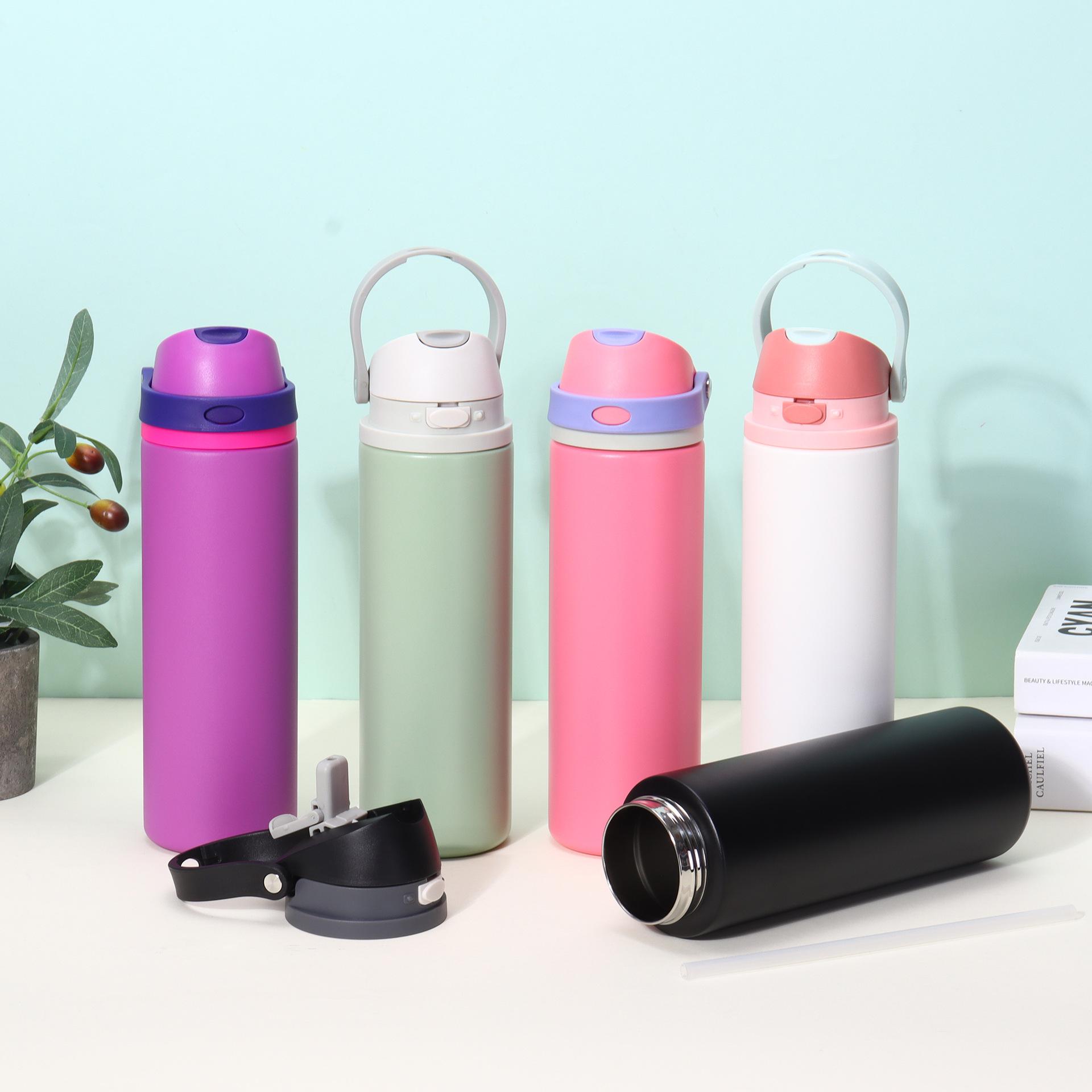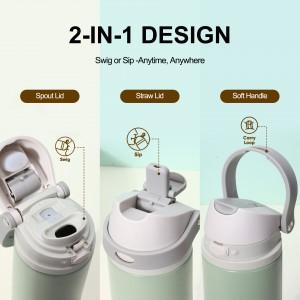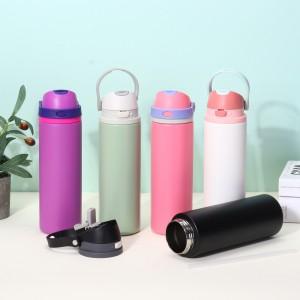
Quality in stainless steel water bottles hinges on several key indicators. Essential factors include the choice of material, which affects durability and safety. Effective design enhances performance, ensuring optimal temperature retention. For instance, stainless steel water bottles do not leach harmful chemicals, making them a safer choice compared to plastic alternatives.
Key Takeaways
- Choose 18/8 stainless steel for safety and durability. This material prevents harmful chemicals from leaching into your drinks.
- Look for double-wall vacuum insulation. This feature keeps beverages cold for up to 24 hours and hot for up to 12 hours.
- Select a bottle with a user-friendly cap style. Options like flip-top or straw lids enhance convenience during activities.
Material Types in Stainless Steel Water Bottles

Food-Grade Stainless Steel
Food-grade stainless steel is essential for ensuring safety and durability in stainless steel water bottles. The most common type used is 18/8 stainless steel, also known as 304 stainless steel. This alloy contains 18% chromium and 8% nickel, which enhances its corrosion resistance and durability. Importantly, food-grade stainless steel prevents the leaching of harmful chemicals and flavors into beverages. Unlike aluminum bottles, which often require an internal liner, 18/8 stainless steel does not impart flavors, making it a safe choice for hydration.
When selecting a stainless steel water bottle, look for certifications that indicate food safety. The FDA (Food and Drug Administration) and LFGB (a stricter European standard) are two key certifications that ensure the materials used in water bottles meet safety standards. Additionally, ensure that the bottle is labeled as BPA-free to avoid health risks associated with this chemical.
Recycled Stainless Steel
Recycled stainless steel is gaining popularity due to its environmental benefits. Many brands now produce stainless steel water bottles using recycled materials, significantly reducing their carbon footprint. For instance, brands like Klean Kanteen and Stanley utilize up to 90% recycled stainless steel in their products.
Using recycled stainless steel does not compromise the durability or safety of water bottles. In fact, stainless steel is known for its strength and resistance to corrosion, making it a long-lasting option. The recyclability of stainless steel contributes to environmental sustainability, as it can be recycled endlessly without losing its properties.
| Brand | Percentage of Recycled Materials |
|---|---|
| Klean Kanteen | 90% |
| Stanley | 90% |
| Bivo | 100% |
Comparison of Stainless Steel Grades
Understanding the differences between various stainless steel grades is crucial for selecting a quality stainless steel water bottle. The most common grades include 304 (18/8) and 316 stainless steel.
| Stainless Steel Grade | Composition | Corrosion Resistance | Applications |
|---|---|---|---|
| 18/8 (304) | 18% Chromium, 8% Nickel | Good | Cookware, food containers, etc. |
| 316 | 16% Chromium, 10% Nickel, 2% Molybdenum | Excellent | Marine equipment, medical devices |
304 stainless steel is suitable for general use but may corrode when exposed to acidic or saline conditions. In contrast, 316 stainless steel offers enhanced resistance to corrosion, making it ideal for water bottles that may contain acidic beverages.
When comparing these grades, consider the following:
- 316 Stainless Steel: Excellent corrosion resistance, especially in chloride-rich environments.
- 304 Stainless Steel: Good corrosion resistance, suitable for various applications.
- 201 Stainless Steel: Lower corrosion resistance, more susceptible to corrosion in aggressive environments.
Choosing a stainless steel water bottle made from high-quality materials ensures safety and longevity, making it a worthwhile investment for hydration needs.
Essential Features of Stainless Steel Water Bottles

Insulation Types
Insulation plays a crucial role in the performance of stainless steel water bottles. High-quality bottles often utilize double-wall vacuum insulation. This design creates an airless space between two walls, effectively preventing heat transfer. As a result, these bottles excel at maintaining the temperature of beverages.
Key Benefits of Double-Wall Vacuum Insulation:
- Keeps drinks cold for up to 24 hours.
- Maintains hot beverages for up to 12 hours.
- Minimizes heat transfer between the inner and outer walls.
The vacuum layer is essential because it eliminates air, which is necessary for heat transfer. This means that temperature escape is nearly impossible, allowing drinks to maintain their desired temperature effectively. In contrast, single-walled bottles do not retain temperature as effectively, making them less suitable for those who require long-lasting insulation.
Cap Styles
The cap style of a stainless steel water bottle significantly impacts usability. Popular options include screw-top lids, flip-top lids, straw lids, and sports caps. Each style offers unique advantages:
- Screw-Top Lids: Provide a secure seal and excellent insulation but may require two hands to operate.
- Flip-Top Lids: Allow for one-handed access, making them convenient for multitasking.
- Straw Lids: Enable sipping without tilting the bottle, ideal for workouts.
- Sports Caps: Offer quick drinking with a high flow rate, favored by athletes.
These variations cater to different user needs and preferences. For instance, a user might prefer a flip-top lid for easy access during a run, while another might choose a straw lid for hydration during intense workouts.
User Feedback on Cap Styles: “I’ve never had a lid that was so effortless and smooth; it makes it easy and fun to stay hydrated all day. It truly doesn’t leak like most bottles.”
Ease of Cleaning
Cleaning is an essential aspect of maintaining the hygiene and longevity of stainless steel water bottles. Several features contribute to the ease of cleaning:
- Wide Mouth: A wider opening allows for easier access when cleaning, reducing the need for specialized brushes.
- Fewer Parts: Simpler designs with fewer components minimize hiding spots for bacteria.
- Dishwasher-Safe: Being able to clean the bottle in a dishwasher is a significant convenience.
- Smooth Interiors: Smooth surfaces are easier to clean and less likely to trap odors or stains.
- Avoid Straws: Straws can complicate cleaning; removable straws are preferable.
Stainless steel’s smooth, non-porous surface prevents bacteria from harboring, making it easier to clean than plastic. Regular cleaning with soap and water is typically sufficient to maintain hygiene. A study comparing microbial populations in stainless steel and PET bottles highlights the importance of routine cleaning. Regular maintenance reduces the risk of microbial contamination and associated health risks.
Brand Reputation and Sustainability in Stainless Steel Water Bottles
Reliable Brands
When selecting a stainless steel water bottle, brand reputation plays a crucial role. Consumers often gravitate towards brands known for their quality and reliability. Some notable brands include:
| Brand | Notable Features |
|---|---|
| Hydro Flask | Durable and can withstand rough use |
| CamelBak | Unique magnetic lid and excellent insulation |
| Owala | Unique design and long-lasting performance |
| YETI | Highly durable and well-regarded in the market |
These brands have established themselves through consistent quality and innovative designs. They often receive awards and certifications, such as Iron Flask Insulated winning the Best Buy award and Klean Kanteen TKWide Recycled Insulated being highly rated and PFAS Free.
Eco-Friendly Practices
Sustainability is a significant concern for many consumers today. Leading manufacturers implement various eco-friendly practices to minimize their environmental impact. These practices include:
| Eco-Friendly Practice | Description |
|---|---|
| Reducing Plastic Use | Promoting stainless steel bottles to decrease reliance on single-use plastic bottles. |
| Addressing Water Scarcity | Encouraging the use of reusable bottles to conserve freshwater resources. |
| Sustainable Packaging | Utilizing eco-friendly materials for packaging to minimize waste. |
| Recycling Initiatives | Encouraging recycling of stainless steel bottles to prevent landfill waste and promote reuse. |
| Reducing Carbon Emissions | Choosing stainless steel over plastic or aluminum to lower carbon footprints during production. |
While producing stainless steel requires significant energy, the long-term benefits of reusability far outweigh the initial costs. A stainless steel water bottle can replace hundreds of single-use plastic bottles over its lifetime, leading to a much lower environmental impact.
Customer Reviews and Feedback
Customer feedback often highlights essential quality factors in stainless steel water bottles. Commonly praised features include:
| Quality Factor | Description |
|---|---|
| Insulation Capabilities | Keeps beverages hot or cold for extended periods |
| Durability | Resistant to dents and damage |
| Design | Aesthetic appeal and functionality |
| Ease of Use | Convenient to carry and drink from |
Consumers appreciate bottles that effectively maintain temperature and are easy to use. However, some reviews also mention concerns such as weight and portability issues. Overall, customer reviews provide valuable insights into the quality and performance of stainless steel water bottles.
Identifying quality in stainless steel water bottles involves several key factors. Consumers should consider the following:
- Material: Look for 18/8 stainless steel, which indicates high quality.
- Insulation: Check for vacuum-sealed double walls to ensure effective insulation.
- Design: A secure leak-proof lid is essential for usability.
- Durability: The exterior should resist chipping and scratching.
- Practical Tests: Perform the Hot Water Test to check insulation effectiveness.
By evaluating these aspects, individuals can make informed purchasing decisions. Choosing high-quality stainless steel water bottles not only promotes health but also contributes to environmental sustainability. These bottles are durable, recyclable, and designed for long-term use, making them a wise investment for hydration needs.
FAQ
What is the difference between 304 and 316 stainless steel?
304 stainless steel offers good corrosion resistance, while 316 stainless steel provides excellent resistance, especially in salty or acidic environments.
How do I clean my stainless steel water bottle?
Clean your bottle with warm soapy water and a soft cloth. For deeper cleaning, use a bottle brush or place it in the dishwasher if it’s dishwasher-safe.
Are stainless steel water bottles safe for hot beverages?
Yes, high-quality stainless steel water bottles are safe for hot beverages. They do not leach harmful chemicals and maintain temperature effectively.
Post time: Sep-11-2025

